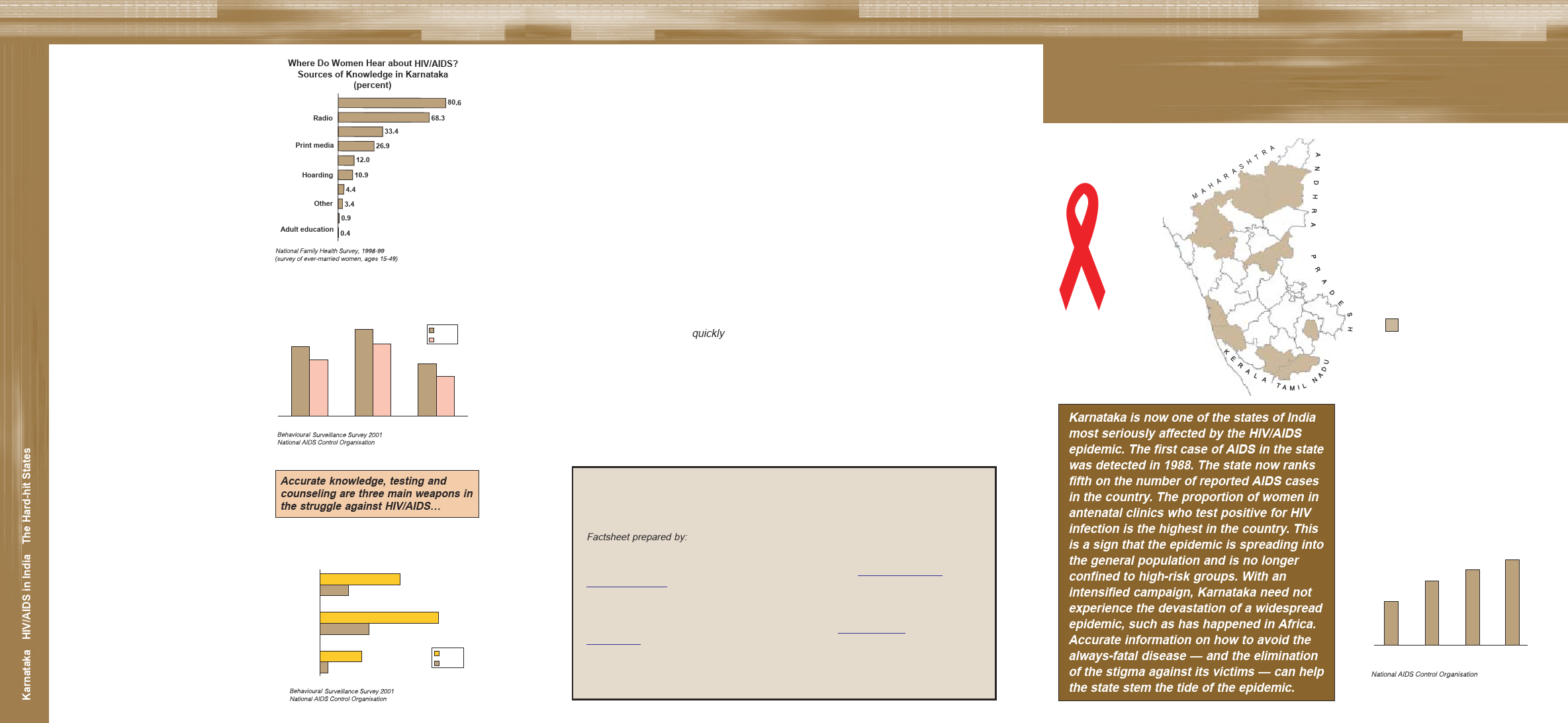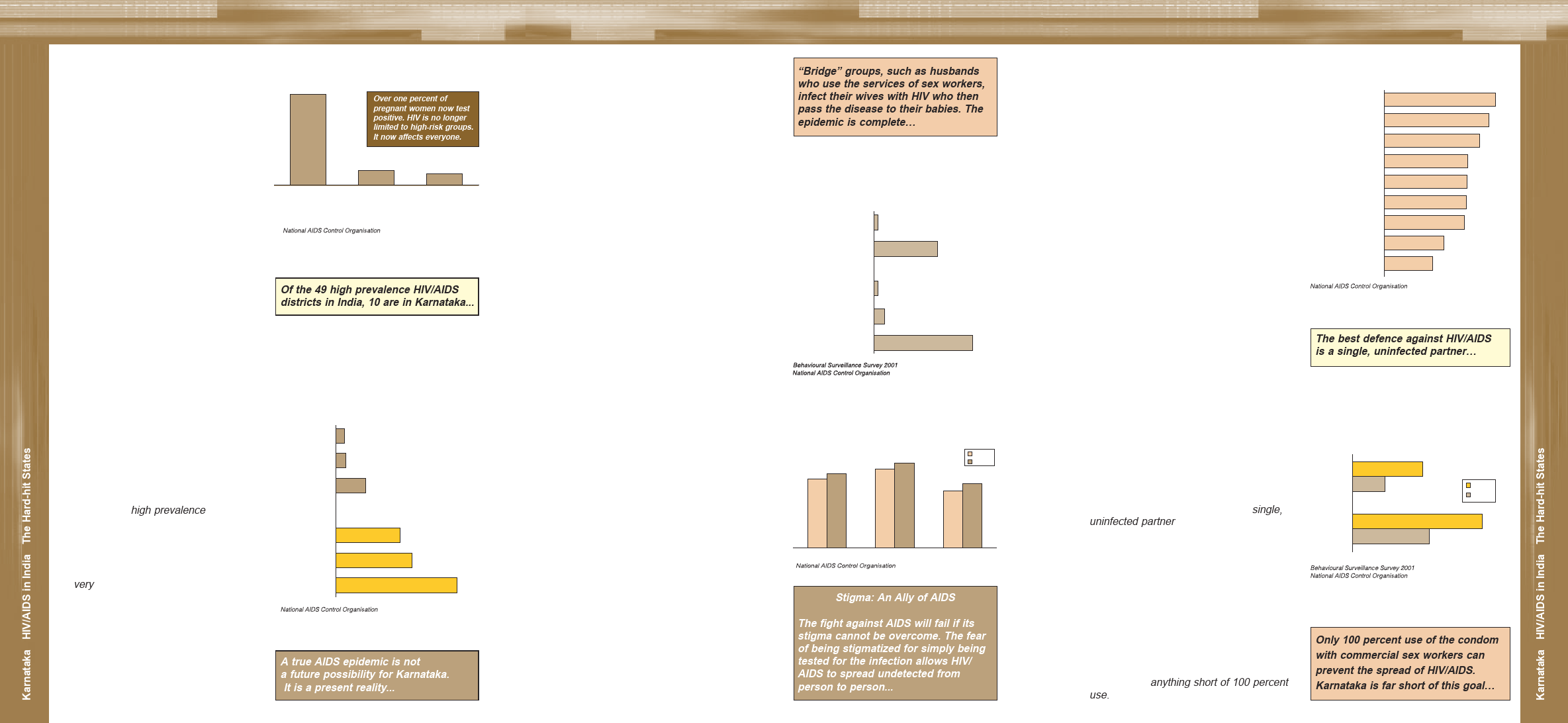 |
HIV Fact Sheet Karnataka |
 |
1 Page 1 |
▲back to top |

People Need HIV/AIDS Information
For people to take steps to avoid HIV/
AIDS, they must first hear of it. In
Karnataka, 84 percent of adults have heard
of the disease, with high awareness in
urban and rural areas. Television is the
most likely source of HIV/AIDS knowledge,
followed by radio. Only 4.4 percent of ever-
married women received information on
the disease from a health worker.
The BSS also revealed that awareness of
the use of the condom as a means to
prevent HIV/AIDS was far from universal.
In the rural areas, about one-third of men
and two-thirds of women were not aware of
its role in disease prevention.
Where Do Women Hear about HIV/AIDS?
Sources of Knowledge in Karnataka
(percent)
Television
Radio
Friend/relative
33.4
Print media
26.9
Cinema
12.0
Hoarding
Health worker
10.9
4.4
Other 3.4
Teacher 0.9
Adult education 0.4
80.6
68.3
Percent Knowing that Consistent Condom Use
Can Prevent HIV/AIDS, Karnataka, 2001
65.8
53.0
82.0
68.1
Urban
Rural
49.4
37.8
Personal experience with the disease is
becoming more widespread. Overall, 17.3
percent of BSS respondents knew of
someone who had died of AIDS, 18.5
percent in urban areas and 16.7 percent in
rural areas.
Both sexes
Male
Female
Accurate knowledge, testing and
counseling are three main weapons in
the struggle against HIV/AIDS…
A significant proportion felt it was possible
to be tested confidentially for the disease
(70.6 percent), but the overwhelming
majority did not know where to go for
testing. Only 20.4 percent of people in
urban areas and 7.3 percent in rural areas
knew where they could be tested. Testing
for HIV is not only in the individual’s own
self-interest, but would act as a strong
deterrent to its spread.
Percent Knowing a Place Where They Could Be
Tested for HIV/AIDS, Karnataka, 2001
20.4
Both sexes
7.3
Male
Female
2.1
12.5
10.7
30.0
Urban
Rural
Karnataka HIV/AIDS in India The Hard-hit States
What must be done?
G The stigma associated with people living with HIV/AIDS must be ended. Women
and orphans are cast from families, children from their school and workers from
their workplace. Ignorance breeds needless fear.
G Confidential testing centres must be made operational in every district. HIV/AIDS
must be fought at the grass-roots level.
G Women are a vital target for information and testing, lest they be left defenceless.
G HIV/AIDS information — and counseling — must be universal. Everyone should
know the truth about HIV/AIDS.
G People must learn that a single, uninfected partner is the best defence.
G Those who do engage in risky behaviour must learn the value of a high quality
condom and how to obtain one.
G Treatment for people living with HIV/AIDS, including antiretroviral drugs, should be
provided free of charge, given that the expense is beyond the reach of many.
G The importance of quickly educating youth is a key element in the campaign.
All the danger signs are there. Knowledge of the disease itself is low, the knowledge
of preventive measures is far short of what is necessary and counseling is
unavailable to many. HIV/AIDS has come to Karnataka and is now a genuine
epidemic.
This series of factsheets on the six hard-hit HIV/AID states (Andhra Pradesh, Karnataka,
Maharashtra, Manipur, Nagaland and Tamil Nadu) are available in English and the
respective state language and are free of charge to individuals and organisations. For
additional copies, please contact the Population Foundation of India at the address below.
Factsheet prepared by:
Population Foundation of India
B-28, Qutab Institutional Area, Tara Crescent, New Delhi 110 016
Telephone: 91-11-2686 7080 Fax: 91-11-2685 2766 e-mail: popfound@sify.com
www.popfound.org
and
Population Reference Bureau
1875 Connecticut Ave., NW, Suite 520, Washington, DC 20009
Telephone: (202) 483-1100 Fax: (202) 328-3937 e-mail: popref@prb.org
www.prb.org
Funding was provided through the generosity of the Bill & Melinda Gates Foundation.
Printed in India at Ajanta Offset & Packagings Ltd., Delhi. November 2003.
Karnataka
HIV/AIDS in India
The Hard-hit States
GOA
A
R
Bidar
T
H
S
A
R
A
H
Gulbarga
A
M
Bijapur
Bagalkot
Belgaum
Raichur
Dharwad
Gadag
Uttara
Haveri
Kannada
Koppal
Bellary
Shimoga
Devangere
Chitradurga
Tumkur
Udupi Chikmagalur
Dakshina
Kannada
Hassan
Tumkur
Kolar
Bangalore
Mandya
Bangalore
Rural
Kodagu
Mysore
Chamaraja-
nagar
High prevalence districts
Map not to scale
Karnataka is now one of the states of India
most seriously affected by the HIV/AIDS
epidemic. The first case of AIDS in the state
was detected in 1988. The state now ranks
fifth on the number of reported AIDS cases
in the country. The proportion of women in
antenatal clinics who test positive for HIV
infection is the highest in the country. This
is a sign that the epidemic is spreading into
the general population and is no longer
confined to high-risk groups. With an
intensified campaign, Karnataka need not
experience the devastation of a widespread
epidemic, such as has happened in Africa.
Accurate information on how to avoid the
always-fatal disease — and the elimination
of the stigma against its victims — can help
the state stem the tide of the epidemic.
Reported Cases of AIDS, Karnataka
1,575
1,790
1,337
918
through
through through through
March 2001 March 2002 Dec. 2002 Aug. 2003
 |
2 Page 2 |
▲back to top |

How Far Has AIDS Spread?
Officially reported AIDS cases from
hospitals and clinics across the state are
only a small fraction of the total. However,
their rise from 918 in March 2001 to 1,790
through August 2003 shows that the
disease is rapidly gaining ground. Of those
1,790 cases, 215 were added in the first
eight months of 2003 alone.
Among adults, males are infected 3:1
compared to females, but the number of
females with HIV/AIDS is rising. About 90
percent of the total reported AIDS cases
are in the age group 15-44.
Percent Testing Positive for HIV at
Sentinel Sites, Karnataka, 2002
13.6
Over one percent of
pregnant women now test
positive. HIV is no longer
limited to high-risk groups.
It now affects everyone.
Sexually
transmitted
disease
patients
2.3
Intravenous
drug users
1.8
Women in
antenatal
clinics
Of the 49 high prevalence HIV/AIDS
districts in India, 10 are in Karnataka...
Measuring the Spread
In order to measure the extent of HIV
infection, testing is conducted at “sentinel
sites” among high and low-risk groups.
High-risk groups are patients at sexually
transmitted disease (STD) clinics and
intravenous drug user (IDU) clinics.
Women treated in antenatal clinics (ANCs)
form the low-risk group.
The National AIDS Control Organisation
(NACO) classifies the HIV/AIDS epidemic
in Karnataka as high prevalence, with five
percent or more of high-risk groups testing
positive and one percent or more of
women in antenatal clinics testing positive.
Rates for women in ANC clinics have now,
in fact, risen as high as five percent. That
is a very high rate for women in the general
population, who typically do not engage in
risky sexual behaviour and whose chance
of contracting HIV is considered low.
Percent of Pregnant Women and STD Patients
Testing Positive for HIV, Karnataka, 2002
ANC Clinics
District Hospital,
Udipi 1.5
General Hospital,
Kollegal, Mysore
1.8
District Hospital,
Bijapur
5.3 5.3
STD Clinics
Kasturba Medical
College, Mangalore
Victoria Hospital,
Bangalore
KR Hospital,
Mysore
11.4
13.6
21.6
The sentinel site data show that the
epidemic has now spread to the general
population. In Karnataka, the HIV/AIDS
outbreak is a genuine epidemic.
A true AIDS epidemic is not
a future possibility for Karnataka.
It is a present reality...
Karnataka HIV/AIDS in India The Hard-hit States
Bridge Groups
The high rate of HIV infection among
women in antenatal clinics indicates that
the disease is being carried to the general
population by a “bridge” group. It is unlikely
that these women contracted HIV through
their own behaviour, but from their
husbands. Karnataka recorded the highest
prevalence of HIV among ANC attendees
in India.
According to the Behavioural Surveillance
Survey (BSS), conducted by NACO in
2001, nearly two-thirds of the clients of
female sex workers were either married
and living with their spouse or with some
other partner. As a result, their regular
partners become exposed to the threat of
HIV as well.
Tragically, pregnant women can pass the
infection to their unborn child or, after birth,
by breastfeeding, an otherwise
recommended practice.
“Bridge” groups, such as husbands
who use the services of sex workers,
infect their wives with HIV who then
pass the disease to their babies. The
epidemic is complete…
Marital Status of Clients of Female Sex
Workers, Karnataka, 2001
(percent)
Not currently married
Living with
sexual partner 2.2
Not living with
sexual partner
35.3
Currently married
Not living with spouse
or other sexual partner
2.2
Living with other
sexual partner
5.6
Living with spouse
54.6
Added Risk with STDs
Sexually transmitted diseases (STDs)
increase vulnerability to HIV infection.
Contrary to the notion that AIDS primarily
affects urban areas, high levels of HIV
have been found among rural STD patients
as well. This raises a serious public health
issue as rural populations have less
access to medical diagnosis and
treatment, including STD services.
The higher rate in rural areas requires
greatly increased efforts for HIV education
outside cities and towns. Reaching down to
village panchayat leaders to convince them
of the need to overcome the stigma
associated with AIDS and the discussion of
it has become a critical need. People fear
the stigma from even being tested,
knowing they are likely to be ejected from
their household, village or school.
Percent of STD Patients Testing Positive for
HIV in Urban and Rural Areas by Sex,
Karnataka, 2001
17.8
16.5
20.3
18.8
Urban
Rural
15.4
13.7
Both sexes
Male
Female
Stigma: An Ally of AIDS
The fight against AIDS will fail if its
stigma cannot be overcome. The fear
of being stigmatized for simply being
tested for the infection allows HIV/
AIDS to spread undetected from
person to person...
HIV Moves through Society
The occupation of STD patients who tested
positive for HIV illustrates how the disease
spreads, especially in the initial stages.
Those with frequent contact with many
customers or clients are more likely to
contract the disease and then spread it to
others.
People from the service class have the
highest prevalence of the groups tested in
Karnataka. Drivers form the second largest
group in HIV infection with 21.9 percent
infected. Truck drivers who travel distances
to many different locations bring the
infection with them, often to areas where
the disease has not yet begun.
Percent Testing Positive for HIV at STD Sites
by Occupation, Karnataka, 2001
Service class
Driver
Agriculture/unskilled
Factory worker
Hotel staff
Unemployed
Business
Housewife
Student
23.3
21.9
20.0
17.5
17.4
17.1
16.8
12.5
10.2
A telling statistic is the high prevalence of
HIV discovered among housewives at 12.5
percent. This high rate of infection is
another signal of the expansion of HIV into
the general public.
The best defence against HIV/AIDS
is a single, uninfected partner…
Consistent Condom Use With Non-regular
Sex Partners, Karnataka, 2001
(percent)
Condom Use Short of Goal
The best defence against HIV is a single,
uninfected partner. When one’s behaviour
is risky, the primary defence is a high
quality condom. Although condom use has
become more widespread, consistent
condom use with a non-regular partner is
relatively infrequent. In the rural areas,
only 13.0 percent used a condom
consistently during the year preceding the
survey, although 30.4 percent did use one
on the most recent occasion. This is a
critical issue in that even relatively high
use of the condom, which is lacking in
Karnataka, is not enough. HIV will spread
steadily with anything short of 100 percent
use.
During the
last
12 months
During last
sexual
intercourse
27.7
13.0
30.4
Urban
Rural
51.1
Only 100 percent use of the condom
with commercial sex workers can
prevent the spread of HIV/AIDS.
Karnataka is far short of this goal…





